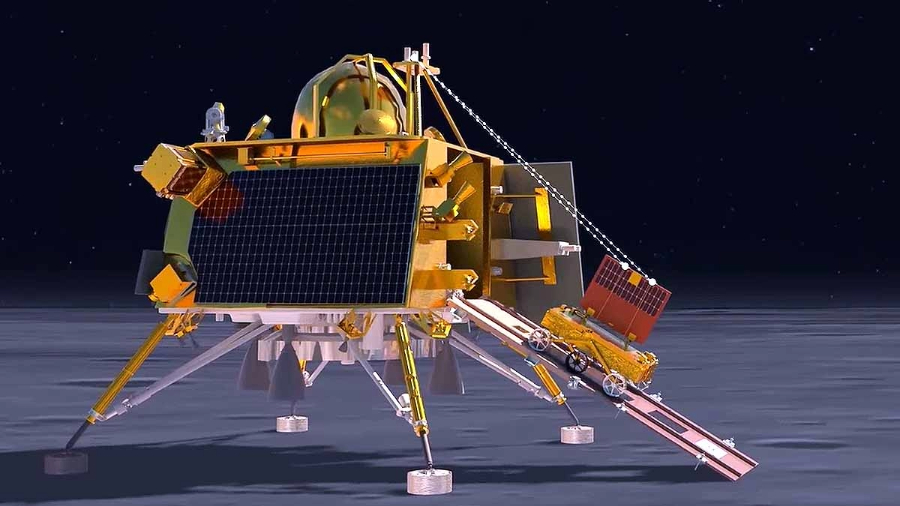Goal of Chandrayaan 3
The goal of Chandrayaan 3 is to platform the capability of landing and operating on the Moon, similar to the previous mission. The lander and rover are equipped with various scientific instruments, including a Langmuir probe to measure changes in plasma density near the lunar surface, a seismometer, and a laser retro-reflector array provided by NASA. Chandrayaan-3 comprises an indigenous Lander module (LM), a Propulsion module (PM), and a Rover. Its primary objective is to develop and showcase new technologies essential for interplanetary missions. The Propulsion module will ferry the lander and rover configuration to a lunar orbit of 100 km. Furthermore, it carries the Spectro-polarimetry of Habitable Planet Earth (SHAPE) payload, which will conduct spectral and polarimetric measurements of Earth from the lunar orbit.
Lander & Rover scientific payloads
Chandra’s Surface Thermophysical Experiment is utilized to measure thermal properties and humidity range. The Instrument for Lunar Seismic Activity (ILSA) is employed to measure seismicity in the vicinity of the landing site. The Langmuir Probe (LP) is utilized to estimate plasma density and its fluctuations. Additionally, a passive Laser Retroreflector Array provided by NASA is integrated for lunar laser ranging studies. The Alpha Particle X-ray Spectrometer (APXS) and Laser Induced Breakdown Spectroscopy (LIBS) are used to determine the elemental composition near the landing site.
The Role of LASER Technology
A passive Laser Retroreflector Array from NASA is accommodated for lunar laser ranging studies such as Altimeters, Velocimeters, Inertial Measurement, Propulsion Systems, Navigation, Guidance and control (NGC), Hazard Detection and Avoidance, Landing Leg Mechanism. The Earth’s conditions are being analyzed by cutting-edge technologies, and specialized tests are being carried out on landers like the Integrated Cold Test, Integrated Hot Test, and Lander Leg mechanism performance test. LASER Induced Breakdown Spectroscopy (LIBS) – Qualitative and quantitative analysis to indicate the elemental nature and to derive the chemical Composition and infer mineralogical composition to further our understanding of the Lunar surface.
Significance of SENSOR Technology
SENSOR technology plays a crucial role in various fields, including medical, automotive, aerospace, and environmental monitoring. The Mars lander mission employs a range of instruments and devices, including Laser Inertial Referencing and Accelerometer Package (LIRAP), Ka-Band Altimeter (KaRA), Lander Position Detection Camera (LPDC), LHDAC (Lander Hazard Detection and avoidance Camera), Laser Altimeter (LASA), Laser Doppler Velocimeter (LDV), Lander Horizontal Velocity Camera (LHVC), Micro-Star sensor, Inclinometer & Touchdown sensors. Additionally, specific specifications have been established for the lander touchdown.
Importance of SOLAR Energy
The Mars Exploration Rover relies on a multi-panel solar array as its primary source of power, which generates up to 140 watts of energy for up to four hours per sol when fully illuminated. The rover requires around 100 watts of energy to operate. Additionally, the rover’s power system includes two rechargeable batteries that supply energy during periods of darkness or low sunlight. However, the batteries will eventually degrade over time and will not be able to recharge to full capacity. The rover is also capable of conducting on-site analysis and transmitting data to its lander for relaying back to Earth.
Shelf life of just two weeks
Pragyan has a life of only one lunar day (14 Earth days). After this, it will follow 14 consecutive, 24-hour-long periods of night, during which Pragyan will brave the -230 degrees cold without power. However, there may be a small chance that when the sun rises next to the moon, Pragyan will heat up, and power up after a couple of days and get back to work. India’s achievement in deploying the Pragyan rover onto the moon’s surface is a significant step forward in lunar exploration. Pragyan, with its array of specialized instruments, will unlock the secrets of the moon’s composition and geology. It will do so during its mission duration on our celestial neighbor.
Presence of life in the future and Peculiarity feature
The LIBS and APXS instruments play a crucial role in conducting qualitative and quantitative elemental analysis, determining chemical composition, and inferring mineralogical composition. These measurements contribute to our deeper understanding of the lunar surface. Additionally, the discovery of smaller planets through reflected light opens up opportunities to explore a diverse range of exoplanets that may potentially be habitable.
Source

